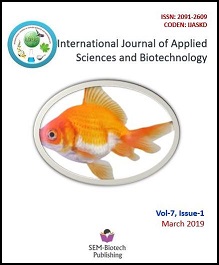GIS and Remote Sensing Supported Soil Erosion Assessment of Kamala River Watershed, Sindhuli, Nepal
DOI:
https://doi.org/10.3126/ijasbt.v7i1.23307Abstract
This study analysed the situation of water-induced soil erosion in Kamala River watershed of Sindhuli, Nepal covering 23,194.33 hectares of land, extending from 85°58'11.6"E to 86°18'16.8"E longitude and 26°56'45.9"N to 27°5'44.4"N latitude. Revised universal soil loss equation was applied in GIS environment using the satellite-based data, field measurements, surveys and lab analysis. R factor predicted from the average annual precipitation. K factor based on the soil texture and organic carbon content. LS factors derived from the DEM of 20m resolution. C factor derived from the NDVI value extracted from Landsat 8 OLI imagery of the pre-monsoon season. P factor assigned according to the land cover of the study area. The study explored the massive diversity of erosion rates even within the narrow span of a landscape in the Churia range of the Himalayan foothills. As predisposed by the diversity of terrain and vegetation cover, and aggravated further by the dominance of silts in the texture of soils, soil erosion rate has been found to vary and noticeably occur in higher ranges of severity. Overall, total potential of soil loss in the watershed was 1.460 million tons/ year, out of which only 0.297 million tons of soil was estimated to be actually eroded from the watershed in the existing conditions. Conservation measures are advisable in the areas having severe soil loss. The resulting soil erosion rate map can be a guideline for developing sustainable land management strategy in the concerned and similar lower foothills of Himalayan mountain landscapes.
Int. J. Appl. Sci. Biotechnol. Vol 7(1): 54-61




